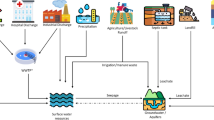Abstract
Methyl ethyl ketone (MEK) is a common groundwater contaminant often present with more toxic compounds of primary interest. Because of this, few studies have been performed to determine the effect of microbial community structure on MEK biodegradation rates in aquifer sediments. Here, microcosms were prepared with aquifer sediments containing MEK following a massive spill event and compared to laboratory-spiked sediments, with MEK biodegradation rates quantified under mixed aerobic/anaerobic conditions. Biodegradation was achieved in MEK-contaminated site sediment microcosms at about half of the solubility (356 mg/L) with largely Firmicutes population under iron-reducing conditions. MEK was biodegraded at a higher rate [4.0 ± 0.74 mg/(L days)] in previously exposed site samples compared to previously uncontaminated sediments [0.51 ± 0.14 mg/(L days)]. Amplicon sequencing and denaturing gradient gel electrophoresis of 16S rRNA genes were combined to understand the relationship between contamination levels, biodegradation, and community structure across the plume. More heavily contaminated sediments collected from an MEK-contaminated field site had the most similar communities than less contaminated sediments from the same site despite differences in sediment texture. The more diverse microbial community observed in the laboratory-spiked sediments reduced MEK concentration 47 % over 92 days. Results of this study suggest lower rates of MEK biodegradation in iron-reducing aquifer sediments than previously reported for methanogenic conditions and biodegradation rates comparable to previously reported nitrate- and sulfate-reducing conditions.






Similar content being viewed by others
References
Agency for Toxic Substances and Disease Registry (2010) Addendum to the toxicological profile for 2-butanone. http://www.atsdr.cdc.gov/toxprofiles/2-butanone_addendum.pdf
Agency for Toxic Substances and Disease Registry (2011) Public health statement for 2-butanone
Bringmann G, Kühn R (1980) Comparison of the toxicity thresholds of water pollutants to bacteria, algae, and protozoa in the cell multiplication inhibition test. Water Res 14:231–241. doi:10.1016/0043-1354(80)90093-7
Caporaso JG et al (2012) Ultra-high-throughput microbial community analysis on the Illumina HiSeq and MiSeq platforms. ISME J 6:1621–1624. doi:10.1038/ismej.2012.8
Együd LG (1967) Studies on cell division: the effect of aldehydes, ketones and α-keto-aldehydes on the proliferation of Escherichia coli. Biosystems 1:14–20. doi:10.1016/0303-2647(67)90015-9
Eubanks EF, Forney FW, Larson AD (1974) Purification and characterization of the nocardial acetylesterase involved in 2-butanone degradation. J Bacteriol 120:1133–1143
Kolb B, Welter C, Bichler C (1992) Determination of partition coefficients by automatic equilibrium headspace gas chromatography by vapor phase calibration. Chromatographia 34:235–240. doi:10.1007/bf02268351
Kozich JJ, Westcott SL, Baxter NT, Highlander SK, Schloss PD (2013) Development of a dual-index sequencing strategy and curation pipeline for analyzing amplicon sequence data on the MiSeq Illumina sequencing platform. Appl Environl Microbiol. doi:10.1128/aem.01043-13
Lee TH, Kim J, Kim M-J, Ryu HW, Cho K-S (2006) Degradation characteristics of methyl ethyl ketone by Pseudomonas sp. KT-3 in liquid culture and biofilter. Chemosphere 63:315–322. doi:10.1016/j.chemosphere.2005.07.067
Mormile MR, Liu S, Suflita JM (1994) Anaerobic biodegradation of gasoline oxygenates: extrapolation of information to multiple sites and redox conditions. Environ Sci Technol 28:1727–1732. doi:10.1021/es00058a026
Muyzer G, de Waal EC, Uitterlinden AG (1993) Profiling of complex microbial populations by denaturing gradient gel electrophoresis analysis of polymerase chain reaction-amplified genes coding for 16S rRNA. Appl Environ Microbiol 59:695–700
Onaca C, Kieninger M, Engesser K-H, Altenbuchner J (2007) Degradation of alkyl methyl ketones by Pseudomonas veronii MEK700. J Bacteriol 189:3759–3767. doi:10.1128/jb.01279-06
Rastogi SC (1993) Gas chromatographic analysis of organic solvent mixtures on capillary columns of different polarity. Chromatographia 37:211–214. doi:10.1007/BF02275862
Schloss PD et al (2009) Introducing mothur: open-source, platform-independent, community-supported software for describing and comparing microbial communities. Appl Environ Microbiol 75:7537–7541. doi:10.1128/AEM.01541-09
Suflita JM, Mormile MR (1993) Anaerobic biodegradation of known and potential gasoline oxygenates in the terrestrial subsurface. Environ Sci Technol 27:976–978. doi:10.1021/es00042a022
US Environmental Protection Agency (US EPA) (2003) Toxicological review of methyl ethyl ketone. EPA 635/R-03/009. Washington, DC
Watanabe K, Kodama Y, Harayama S (2001) Design and evaluation of PCR primers to amplify bacterial 16S ribosomal DNA fragments used for community fingerprinting. J Microbiol Methods 44:253–262. doi:10.1016/s0167-7012(01)00220-2
Weisburg W, Barns S, Pelletier D, Lane D (1991) 16S ribosomal DNA amplification for phylogenetic study. J Bacteriol 173:697–703
Acknowledgments
The authors wish to thank Jody Smiley (Virginia Tech) for chemistry analytical assistance, Marian Alicea (Virginia Tech), Pan Ji (Virginia Tech), and Hannah Delos Reyes (Rutgers University) for assistance preparing samples for amplicon sequencing. We thank the Atlanta office of AMEC Foster Wheeler for their assistance with sample collection and site data.
Author information
Authors and Affiliations
Corresponding author
Electronic supplementary material
Below is the link to the electronic supplementary material.
Rights and permissions
About this article
Cite this article
Fahrenfeld, N., Pruden, A. & Widdowson, M. Kinetic and microbial community analysis of methyl ethyl ketone biodegradation in aquifer sediments. Biodegradation 28, 27–36 (2017). https://doi.org/10.1007/s10532-016-9775-4
Received:
Accepted:
Published:
Issue Date:
DOI: https://doi.org/10.1007/s10532-016-9775-4




